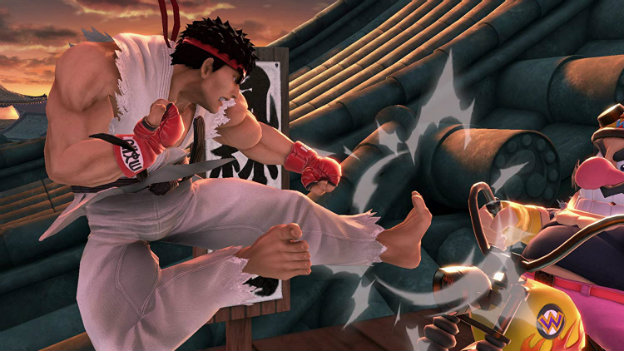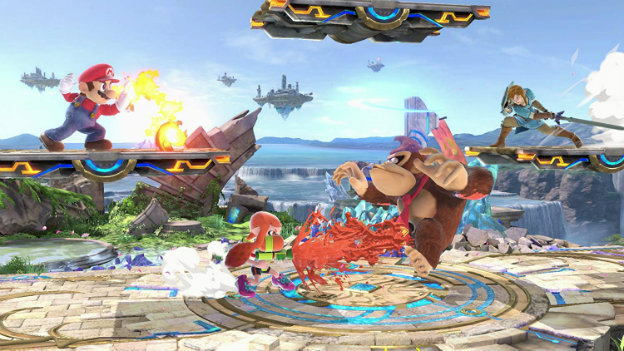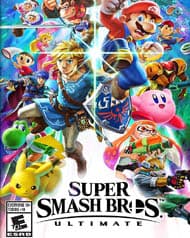Everyone’s Here, and We Mean Everyone
Everyone is here. That’s what Nintendo told us when Super Smash Bros. Ultimate was fully unveiled during a Nintendo Direct. That reveal, that this would truly be the “ultimate” Smash Bros. with a roster of every character who has ever appeared in the series to date and then some, was truly something special. That certainly makes the game’s titles, Ultimate in the West and Special in Japan, appropriate. After several decades of once a generation releases, it’s not hard to imagine this game as the peak of the mountain. It’s not just everyone (and more on that later), it’s everything, with so many granular changes to the Super Smash Bros. formula that it’s hard to even think of anything that wasn’t considered. Super Smash Bros. Ultimate is not just a humongous crossover fighting game, this is the fifth game in a series that has, from the beginning, been built on intense polish and attention to detail. This is Super Smash Bros. in its most scientifically, mathematically curated form. It’s a lot to take in.
Super Smash Bros. has been expanded upon so many times, it almost feels like it’s on the verge of collapsing upon itself. It’s like multiple games in one packages at this point, not unlike Call of Duty: Black Ops 4. Each different way to play Super Smash Bros. Ultimate lives in its own menu, even when the top-level option doesn’t point directly to that mode. Multiplayer lives in “Smash,” “Spirits” is the new single player mode, and your more practice-oriented space lives in “Games & More.” Within each of these spaces is a distinct experience, but each one shares the same foundation. And that foundation sits on top of years and years of iteration and adjustment, each with the same director overseeing everything. As Masahiro Sakurai has yet to leave the series behind, the lineage of the series, should you be one of the fans who has been here since the beginning, is something you can actually feel.
I can’t speak to the real nitty-gritty of Super Smash Bros. Ultimate, the things like frame data and the physical specifics, but as familiar as it is, it also feels different enough from the previous title that any fears of this just being a port hidden under so much window-dressing are unfounded. While the previous Super Smash Bros. ended up being a more defensive game in some ways, Ultimate is much more aggressive. A lot of that is fueled by tweaks to both the Final Smash system, as well as how damage scales based on the number of players. I won’t get into that second point too much, but generally speaking, it takes a bit more effort to actually get that K.O. on your opponent. That, plus some extra visual flourish a near 100% lethal blow provides, encourages much more aggressive play.
Final Smashes, the sort of super move equivalent of the series, have been changed a lot for this game, tweaking and even replacing some for the sake of balance. These moves are generally more single-target oriented now, but also appear more often overall. There’s also an option to toggle a meter instead of chasing the Smash Ball, an option that is actually a static part of other modes. This makes the Final Smash feel more like a regular part of the mechanics players should be excited about, instead of Just Another Item for hardcore players to turn off entirely. But the different toggles are still there, and have multiplied, in what contributes to the incredibly hyperbolic statement I started this review with.
If you can think of it, Super Smash Bros. Ultimate not only probably has an option for it, but those options have all been moved around and placed in more convenient, accessible places. There are even spaces to save presets. It’s so much less of a pain in the ass and more user-friendly to actually adjust and customize your Super Smash Bros. experience beyond turning everything on or off, which in my experience is what people generally did before. The game feels more modular now, with all the different ways you can tweak it, how easy it is to make alterations, and how you can store any changes you make and access them before you even start picking characters.
Speaking of characters, when that legendary Nintendo Direct said that everyone is here, Nintendo didn’t just mean the roster of dozens of classic Nintendo characters. Nintendo meant “everyone,” as close to literally as possible. I’m talking about the new Spirits concept, something that has been the most divisive aspect of Super Smash Bros. Ultimate since it was revealed. Spirits are a replacement of sorts for trophies, the old Smash unlockable that saw players collecting 3D renders of various characters, locations, items, and more from throughout Nintendo history. Now, those 3D models have been replaced by high-resolution art assets that have already existed and the scale has been increased exponentially. Hundreds of spirits are in the game, well over the usual amount of trophies. These collectibles have also extended to not only characters from beyond Nintendo, giving tons of support to the third-party presence in the game, but also to an entire new way to play Super Smash Bros. in a game mode revolving almost entirely around them.

Spirits are, somehow, my favorite part of Super Smash Bros. Ultimate. Sure, nothing beats just throwing down with a group of friends, but there are external forces at work there. When I’m at home by myself or out with my Nintendo Switch in handheld mode, I’m messing around with the Spirits modes. This is because Spirits expertly takes advantage of the raw appeal of building a collection, in much the same way “gacha” character-collecting mobile games such as Fire Emblem Heroes or Dragalia Lost do. I chose these two examples, as they are both Nintendo-published mobile games, signifying that Nintendo has not only explored this space, but in Super Smash Bros. Ultimate wanted to take the core appeal of these kinds of games and insert it into its console offerings. And it works so well, I can’t stand it. I’m addicted.
There are two different ways to collect Spirits. In one, the fancy-schmancy World of Light mode, you play through an enormous series of levels on a stylish game board, making your way through unlocking both Spirits and fighters to use along the way, even using new Spirit unlocks to pass barriers based on who those characters are. In the other mode, Spirit Board, an ever-revolving door of Spirits appears that offer you lightning-quick play sessions via special battles that give you constant chances to unlock something new, adapt to bizarre situations, and stop whenever you’ve had your fill. These modes are two sides of a coin, one designed to keep you playing in longer sessions, one designed to eat up as little or as much as you want, but gives you resources to use in the first.

When it comes to using the Spirits, they feed into the process of acquiring more by boosting your fighters’ stats and giving them special abilities, some of them designed to get you through otherwise unbeatable conditions. These Spirits level up and have a very mobile-like type triangle that gives you advantages or disadvantages based on your current challenge. It’s all very familiar territory if you play mobile games, down to feeding resources into each Spirit to level them up, evolve some of them to new forms, and even fuse them together to create new Spirits entirely. It’s the best part of gacha gaming, without the worst part. All of this is just part of the game, and it doesn’t demand a single extra cent. Spirits is an emblematic testament to the hybrid nature of the Nintendo Switch as a platform, sitting in a space that embraces the natural appeal of both console and mobile gaming concepts.

I feel like I’ve barely scratched the surface here, and there’s so much more I could cover. But playing Super Smash Bros. Ultimate is really about carving your own personality into it. You can choose the way you want to play and benefit accordingly, always unlocking new characters no matter what modes you play and giving you a ludicrously high play value ceiling once you have everyone. From there, you can play multiplayer until your wrist stops functioning. Collect all the Spirits, work for the highest Classic scores, and so on. I’ve been playing for hours and still don’t have all the characters, and I still feel like there are menu options I haven’t even touched yet. But at the same time, I feel like I’m deeply satisfied, as what I have chosen to do has scratched gaming itches for me I didn’t even know a Super Smash Bros. game was capable of. This is a massive game in both scale and cultural weight, one that wears its far-reaching subtitles as badges of pride.
RATING OUT OF 5 RATING DESCRIPTION 5.0 Graphics
So many clashing sources and styles beyond Nintendo, yet it’s all brought together with a distinct style that screams Super Smash Bros 5.0 Control
As responsive as ever, with new mechanics for new characters and a new parry-like perfect dodge. Everything handles like a dream 5.0 Music / Sound FX / Voice Acting
New remixes, old remixes, and original music powers a soundtrack of literally hundreds of tracks 5.0 Play Value
If you’re not into Spirits mode, there’s still a super high replay ceiling with dozens of characters, online play, and lots of mode. If you do like Spirits mode, good luck playing other games for the rest of 2018 5.0 Overall Rating – The Best
Not an average. See Rating legend below for a final score breakdown.
| Review Rating Legend | |||
|---|---|---|---|
| 0.1 – 1.9 = Avoid | 2.5 – 2.9 = Average | 3.5 – 3.9 = Good | 4.5 – 4.9 = Must Buy |
| 2.0 – 2.4 = Poor | 3.0 – 3.4 = Fair | 4.0 – 4.4 = Great | 5.0 = The Best |
Game Features:
